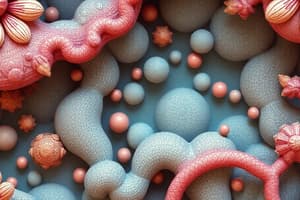Podcast
Questions and Answers
Bone cell, muscle cell, nerve cell, and red blood cell are examples of what level of organization?
Bone cell, muscle cell, nerve cell, and red blood cell are examples of what level of organization?
- Organ System
- Cell (correct)
- Organ
- Tissue
What is the thick, hard outer covering that protects and supports an animal's body, such as that of a scorpion, called?
What is the thick, hard outer covering that protects and supports an animal's body, such as that of a scorpion, called?
- Skeleton
- Hydrostatic skeleton
- Exoskeleton (correct)
- Shell
What is the primary difference between a tissue and an organ in terms of their biological organization?
What is the primary difference between a tissue and an organ in terms of their biological organization?
Tissues are composed of similar cells performing specific functions, while organs are composed of different tissues working together to perform complex functions.
Match the animal tissue to its primary Function:
Match the animal tissue to its primary Function:
Which organ system is primarily responsible for the breakdown and absorption of nutrients from food?
Which organ system is primarily responsible for the breakdown and absorption of nutrients from food?
Which organ system is responsible for the movement of the body?
Which organ system is responsible for the movement of the body?
Which organ system is responsible for taking in oxygen and releasing carbon dioxide?
Which organ system is responsible for taking in oxygen and releasing carbon dioxide?
What type of joint is the elbow?
What type of joint is the elbow?
Flashcards
Animal Cell
Animal Cell
A basic unit of life in an animal.
Tissue
Tissue
A group of similar cells performing a specific function.
Organ
Organ
A structure made of different tissues working together.
Organ System
Organ System
Signup and view all the flashcards
Exoskeleton
Exoskeleton
Signup and view all the flashcards
Muscle Tissue Function
Muscle Tissue Function
Signup and view all the flashcards
Connective Tissue Function
Connective Tissue Function
Signup and view all the flashcards
Hinge Joint
Hinge Joint
Signup and view all the flashcards
Study Notes
- Cells are organized into tissues, tissues into organs, organs into organ systems, and organ systems into an entire organism.
- There are different types of cells in the body, including nerve cells, red blood cells, bone cells, and muscle cells.
Levels of Organization
- Cells: The basic unit of life.
- Tissues: A group of similar cells that perform a specific function.
- Organs: A structure made up of different tissues that work together to carry out a specific function. An example is the Heart, liver, and brain.
- Organ Systems: A group of organs that work together to perform a major bodily function.
- Organisms: A complete living being.
Animal Tissues
- Muscle tissue functions for movement.
- Connective tissue provides structure and support, and connects tissues.
- Nervous tissue carries messages to and from the brain.
- Epithelial tissue provides a protective outer layer of skin and lines major organs and body cavities.
Organ Systems
- The organ systems include; the nervous system, muscular system, digestive system, respiratory system and skeletal system.
Exoskeleton
- A thick, hard outer covering that protects and supports an animal's body, like a scorpion's is called an exoskeleton, it is a hard outer covering. An example is crabs and snails.
Hydrostatic Skeleton
- Hydrostatic skeletons provide fluid support by using an internal cavity that's surrounded by a muscle, moves by pushing fluid. An example including flatworms, anemones, and earthworms
Endoskeletons
- Endoskeletons are inside, hard skeletons that support. An example is humans and dogs.
Joints
- The elbow is a hinge joint moving like a door.
- Ball and socket joints allow bones to move and rotate in nearly all directions, such as hips and shoulders.
- Hinge joints allow bones to move back and forth in a single direction, such as fingers, elbows, and knees.
- Pivot joints allow bones to turn, such as the neck and lower arm below the elbow.
Muscles
- Muscles are strong tissue moving the skeleton.
- Muscles can contract (get smaller and shorter) but can also relax (back to their normal length).
- Muscles have many mitochondria.
Studying That Suits You
Use AI to generate personalized quizzes and flashcards to suit your learning preferences.




